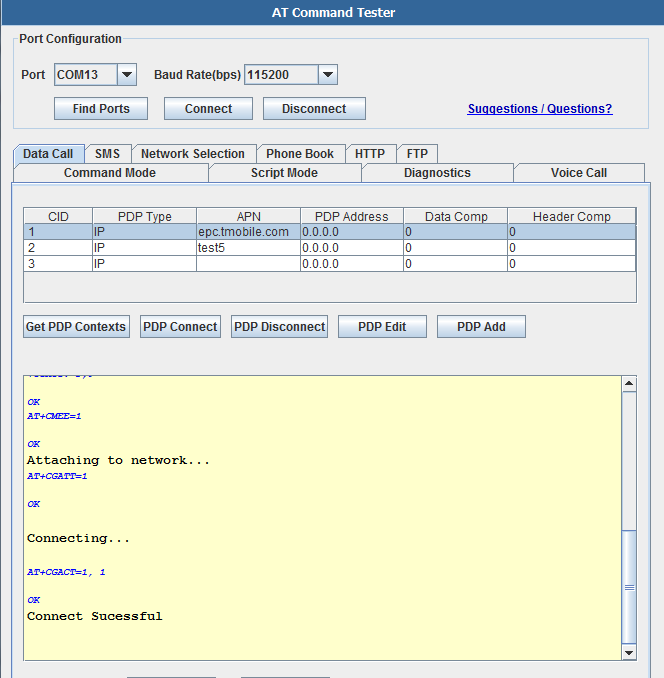Quad-band GPRS/GSM Shield for Arduino Mega
Contents
Introduction
LinkSprite SM5100B GSM/GPRS module: a miniature, single-side board, quad-band GSM 850/EGSM 900/DCS 1800/PCS 1900 module, ready for integration in various kinds of Fix wireless phones and other wireless devices.
USA providers are all on 850/1900Mhz and pratically all the rest of the world uses 900/1800Mhz.
Features
Application Ideas
Cautions
Schematic
Specification
| Temperature range | Normal range: -10°C to +55°C (full compliant)
Storage: -40°C to +85°C |
| Weight | < 9g |
| Physical dimensions | 35.0X39.0X2.9 mm (typical) |
| Connections | 60 pins |
| Power Supply | VBAT: 3.3V to 4.2V range, 3.6V typical. |
| Power consumption | Off mode: <100uA
Sleep mode: <2.0mA Idle mode: <7.0mA (average) Communication mode: 350 mA (average,GSM) Communication mode: 2000mA (Typical peak during TX slot,GSM) |
| Li-ion Battery charging management and interface (OPTION) | Li-ion Battery charging management is included. The charger interface is provided on 60-pin connector.
(only for 3.7V Li-ion Battery) |
| Frequency bands | EGSM900 +GSM850+ DCS1800+PCS1900 |
| Transmit power | Class 4 (2W) for EGSM900/GSM850
Class 1 (1W) for DCS1800/PCS1900 |
| Supported SIM card | 3V/1.8V SIM card. (auto recognise) |
| Keyboard interface | 4x6 keyboard interface is provided |
| UART0 interface with flow control | Up to 460 kbps
Full hardware flow control signals (+3.0V) are provided on 60 pins. |
| UART1 interface without flow control | 2-Wire UART interface
Up to 460 kbps |
| LCD interface | Support standard SPI interface |
Pin definition and Rating
Mechanic Dimensions
Usage
Due to the large current of the GPRS module, a wall adaptor is recommended: http://www.cutedigi.com/product_info.php?products_id=4184
Hardware Installation
Tutorial 1
Jumpers position:
J1: 5100RX to TX1
J2: 5100TX to RX1
Pass through code:
<syntaxhighlight lang="c">
- include //Used for string manipulations
char incoming_char=0; //Will hold the incoming character from the Serial Port.
void setup()
{
//Initialize serial ports for communication.
Serial.begin(9600);
Serial1.begin(9600);
Serial.println("Starting SM5100B Communication...");
}
void loop()
{
//If a character comes in from the cellular module...
if(Serial1.available() >0)
{
incoming_char=Serial1.read(); //Get the character from the cellular serial port.
Serial.print(incoming_char); //Print the incoming character to the terminal.
}
//If a character is coming from the terminal to the Arduino...
if(Serial.available() >0)
{
incoming_char=Serial.read(); //Get the character coming from the terminal
Serial1.print(incoming_char); //Send the character to the cellular module.
}
}
</syntaxhighlight>
Programming
AT Command Tester Application
AT Command Tester is a free online tool test AT Commands and other modem functionalities of 2G modules (GPRS/EDGE) , 3G Modules (HSDPA/EVDO) and 4G Modules (LTE).AT Command Tester tool connects to the modem port of the device and can test various modem functions such as getting device information, gprs data call, voice call,http access, checking signal condition, network registration, SMS functions, SIM access, phonebook functions etc.
In the 'Port Configuration' section of the tool, users can search for available ports using the 'Find Ports' button. Then using the 'Connect' button, users can connect to the modem port of the device.
In the 'Command Mode' tab of AT Command Tester, single AT commands can be sent. The drop down list provides AT command description and examples. Users can modify the default command settings.
Under the 'Script Mode' tab, multiple AT commands can be sent at a time. Users can add descriptive comments and save the script on their local machine.
Data Call
To make a data call with the modem, you need to connect to the APN of the carrier network. The carrier APN and other required information are stored in the SIM card and are referred as PDP contexts. Typically multiple PDP contexts are stored in the SIM for different call types. With the AT Command Tester you can edit/add/delete PDP contexts in a easy to use user interface.
Typical call setup sequence,
+CGDCONT: 1,"IP","epc.tmobile.com","0.0.0.0",0,0
+CGDCONT: 2,"IP","test5","0.0.0.0",0,0
+CGDCONT: 3,"IP","","0.0.0.0",0,0
OK
Checking registration status...
+CREG: 0,1
OK
The device is registered in home network.
Checking if device is already connected...
+CGACT: 1,0
+CGACT: 2,0
+CGACT: 3,0
OK
Attaching to network...
AT+CGATT=1
OK
Connecting...
OK
Connect Sucessful
SMS
The SMS tab of the 'AT Command Tester' tool provides the interfaces to send SMS messages. You can also list/view/delete SMS messages stored on the SIM.

General sequence for sending SMS message,
Checking registration status...
+CREG: 0,1
OK
The device is registered in home network.
AT+CMGS="858XXXXXXX"
> Test Message with AT Command Tester�
+CMGS: 19
OK
SMS Send successful
Network Selection - This tab allows the user to manually select available networks. Modems are typically set for automatic network selection. 'Find Networks' button will command the modem to scan for available networks.
AT+COPS command will initiate network scan in the modem,
Finding Networks. Please wait..
+COPS: (2,"T-Mobile","T-Mobile","310260"),(1,"AT&T","AT&T","310410"),,(0,1,4),(0,1,2)
OK
Networks found
Phonebook
With the 'Phone Book' tab, you can add/delete/read phone book entries stored on the SIM,
Getting phonebook entries..
+CPBR: 1,"*233",129,"Refill Now"
+CPBR: 2,"#999#",255,"Check Balance"
+CPBR: 3,"8878878878",129,"Test"
OK
FAQ
Please list your question here:
Support
If you have questions or other better design ideas, you can go to our forum to discuss or creat a ticket for your issue at linksprite support.
Resources
- User manual
- Reference
- Antenna Options
- SMS Application Note
- GPRS Application Note
- AT commands manual
- Tutorial
How to buy
Here to buy Quad-band GPRS/GSM Shield for Arduino Mega on store
See Also
Other related products and resources.
Licensing
This documentation is licensed under the Creative Commons Attribution-ShareAlike License 3.0 Source code and libraries are licensed under GPL/LGPL, see source code files for details.





